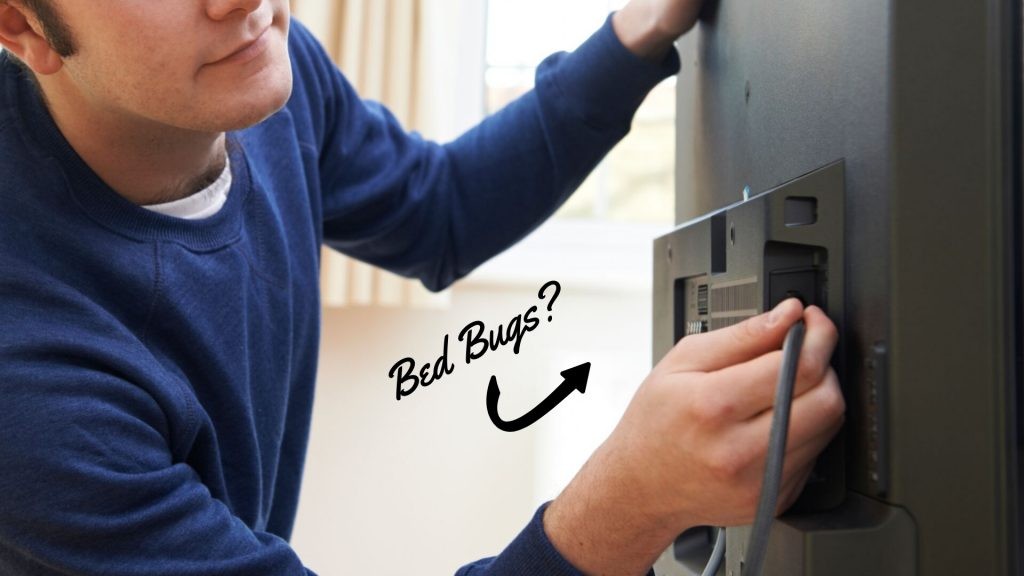When most people think of bed bugs and their hiding spots, beds, mattresses, and furniture come to mind. The truth is that these pesky bugs are overwhelmingly good at hiding so much that nothing in your home is safe. Yes, you heard me right, not even your precious electronic appliances are safe!
The thought of bed bugs in your electronic appliances is cringe-worthy, but you don’t have to dispose of them once infested. With a bit of reading, you can learn everything there is to know about getting rid of bed bugs in electronics.
Table of Contents
Can bed bugs live in electronic appliances?
Bedbugs are notoriously good at hiding and spend most of their time searching for suitable places to hide. Everything in your house is at risk of a bed bug infestation, and your electronic devices are not spared.
Bedbug infestation in electronics is rare and mostly happens when the infestation rate is high. Bedbugs will squirm into your electronics to seek shelter, lay eggs, and crawl out later in search of blood.
When do bed bugs infest electronic appliances? Due to their tiny sizes, they can virtually enter any electronic in your home through trifling openings. All the electronics in your house risk a bedbug infestation.
Bed bugs, as their name suggests, often hide in a bed and its surrounding areas. You will only find bed bugs in your electronic appliances under unique circumstances. These circumstances include:
- If your electronic appliances are too close to your bed, bedbugs might crawl into them. Bedbugs will always hitchhike at items close to you while you sleep. Some bed bugs will hide in your bedding, mattresses, and the bed itself, while other stubborn ones will find their way to your electronics.
- If you sleep on the couch and the TV is nearby, bedbugs are more likely to crawl and hitchhike at the electronic devices. Similarly, bedbugs will crawl into electronic appliances such as laptops if you tend to use and leave them where you sleep.
- Bed bugs will move into your electronics if you have them in contact with house walls. This practice increases the risk of bedbugs moving into your electronics.
- If you have a full-scale bed bug infestation, the bugs will have no option but to crawl into anything hospitable in your house. The pesky bugs will start by moving into small electronic devices, such as the alarm clocks by beds, before transiting into more significant devices, such as televisions.
How bed bugs get into your electronic appliances
Bedbugs crawl into your electronic devices from other hiding spots in your house, such as bedding. These pesky bugs keep crawling in your search for food and better hiding spots. During this process, they might cross your electronic devices and hop into them.
Bedbugs find electronic devices warmer than other hiding spots and prefer them to other customary hiding places. Bedbugs multiply faster since a single mature female can lay one to five eggs daily. This can easily translate to thousands depending on the number of bedbugs on your device. Your electronic device will have new young quests after two weeks since laid eggs will hatch.
If you buy second-hand electronics, you risk taking home-infested electronics. It is challenging to examine electronics for bedbugs since you might want to access the device’s internal parts. If you successfully access the device’s internal components, you will likely miss noticing their eggs and young bugs. Their sizes are too small to be seen by the naked eye.
Telling if your electronic appliances are infested
You can tell if your electronics have bed bugs since you can see them. You can come across bedbugs while using your electronic device. For instance, you might see bedbugs crawling on the screen while watching your TV or laptop. Also, when accessing electronic devices such as fridges and bed alarms, you can find them fortuitously.
Bedbugs have a strong, musty odor similar to that of coriander. The scent is unpleasant if the concentration of bedbugs on the electronic device is high. If suddenly your electronic devices start having a sweet smell, you might have bed bugs.
There are many ways to tell if your electronic devices have bedbugs. You will find their fecal spots, egg shells, and exoskeletons if you have bedbugs. This is the easiest method to affirm the presence of bedbugs. You can damage the device during this process. Hire an expert to complete the check.
Common electronic appliances that can get bed bugs
Some electronics are more vulnerable to bed bugs than others. Here are some everyday electronics in homes that can get bed bugs:
Television
TVs are becoming increasingly popular with the dawn of the 21st century, and everyone has them. Some individuals have upped the game and have more than one TV in their house. I bet you do too. However, placing TVs close to your bedding and walls is risky since it attracts bedbugs.
Desktop Computer
Desktop computers suffer similar bedbug infestation risks to television. Computers have large air holes to control heat problems. However, it is not only air that passes through, and the bugs always join the party. When you use desktop computers, they heat up, thus providing a suitable warm condition for the bugs hitchhiking in them.
Laptops
You often place your laptop on beds, bedside tables, bedroom couches, and other high-risk spaces. This puts your personal computer at a high risk of getting bed bugs. It is only during this contact that the bedbugs have a chance to crawl into them.
Vacuum cleaners
What do you do when you want to get bedbugs out of your house? Vacuum clean. Vacuuming cleaning infested clothing, bedding, and other household appliances do not kill bedbugs or their eggs. The cleaning machine does little harm to the bugs since it only sucks and squashes them into the vacuum bag.
Some bedbugs might die during the vacuuming process, while others will survive and search for a way out. Vacuum cleaners can get bed bugs if you do not follow the proper disposal procedure after vacuuming to remove bed bugs.
Exterminating bed bugs in electronic appliances
You don’t have to dispose of your electronic devices if bed bugs invade them. There are a few ways you can use to get rid of them. Here are some that you should know:
Heat Treatment
Heat treatment is one of the methods to control bedbug infestation in your electronics. You cannot use conventional bed bug treatment methods since dust, such as diatomaceous earth, and moisture-based treatments can damage your electronics.
You can use a quality heater to exterminate bed bugs in your electronic devices. It would be best to regulate the heat treatment procedure since excessive heat can damage your electronics.
Vacuuming
Using a vacuum cleaner to clean electronic devices would be best. The vacuum cleaner sucks the bed bugs out without damaging your electronic devices. However, it would help if you were cautious about the intensity of the pressure exerted on the machine to minimize damage.
Isolation
It is the least of your intention for the bedbugs to crawl into other electronics in the house. Isolation would be a preventive rather than a curative measure and is the surest way to control infestation in your home. Isolate all infested electronics while they await treatment.
Bagging in vacuum-sealed bags
Bagging electronics vacuum-sealed bags would prevent the bedbugs from crawling into or out of the devices. It would help if you kept infested electronics in vacuum sealed bag to prevent bedbugs from crawling out. Similarly, you can bag other electronics in the house to stop bed bugs from moving in.
Final Thoughts
Electronic appliances are not bed bugs’ favorite hiding spots, but finding them is not impossible. They are annoying and extremely good at survival, but this does not mean you have to eliminate your electronic appliances. The methods of removing bed bugs in electronic appliances outlined in this post will help eliminate them.
FAQs
Can bed bugs damage your electronic devices?
Bedbugs will get into your electronics but won’t inflict any significant damage.
Can second-hand electronics have bed bugs?
Depending on where you purchased them, second-hand electronics can have bedbugs. Always do bedbug scans before purchasing second-hand electronics.
Can bed bugs live in cell phones?
No. Bedbugs cannot live in your phone since the charging and earphone ports openings are small and sealed inside.
How long can bed bugs live in electronics?
Bedbugs can live for over a year in your electronics because they can stay longer without food.

